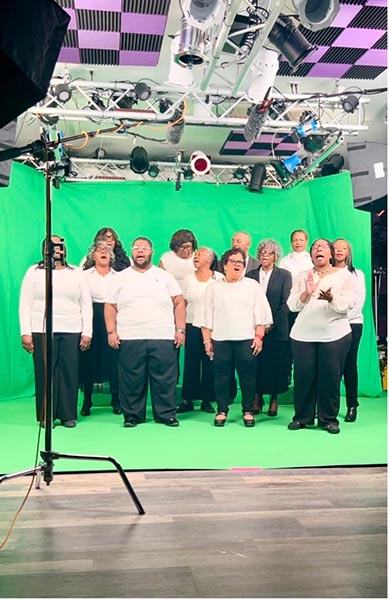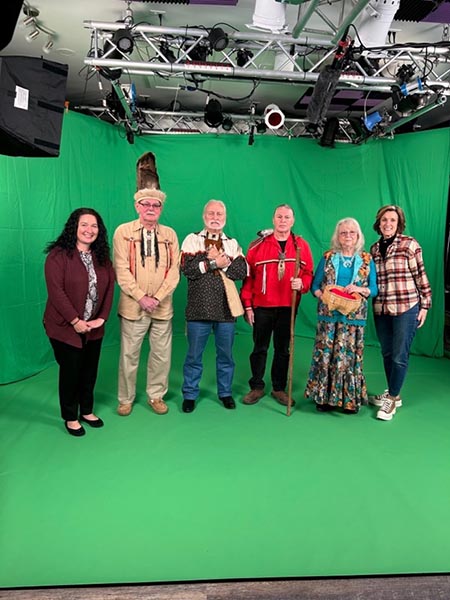Last fall, Lisa Challenger, executive director for the Beach to Bay Heritage Area(BBHA), headquartered in Berlin, Md., heard about something new: augmented reality holotwins. Once she saw examples in action, her creative brain came alive. Suddenly, she had a new tool in her toolbox for telling the stories of the historic areas promoted and protected by BBHA and for more deeply engaging with those who come to visit them.
To pursue the opportunities offered by holotwins, Challenger engaged with RealityBLU, which creates holotwins through its WorldViewAR platform. After securing the funding, she worked to develop three holotwins for use in BBHA’s historic areas. Just hours before this writing, studio videotaping wrapped up and BBHA is now awaiting receipt of the QR codes and links from RealityBLU so they can distribute the holotwins via interpretive signage and text messaging.
Who Is Beach to Bay and Why Do They Need Holotwins?
The Beach to Bay Heritage Area is one of Maryland’s 13 designated historic areas. Located on the state’s lower Eastern Shore, it extends from Smith Island in the Chesapeake Bay to Assateague Island along the Atlantic Coast and from the Nanticoke River to the Pocomoke River. BBHA is dedicated to promoting, preserving, and protecting the cultural heritage, historical linkages, and natural assets of Maryland's Lower Eastern Shore, including its Native American, African American, and seafaring heritage.
Examples of its partners include:
- Furnace Town Historic site, located in Snow Hill, Md., an area filled with living history, from community gardens to blacksmiths shops.
- Poplar Hill Mansion, a historic house museum in Salisbury, Md., that interprets the Federal period of history through the lives of the people who once lived in the 1805 manor house, including the town’s first surgeon.
- Germantown School, located in Berlin, Md., one of 5,000 Rosenwald schools in the South, dedicated to providing state-of-the-art education to students in the African American community in Germantown from 1923 to the late 1950s.
- Smith Island Cultural Center, depicting the rich lifestyle of the watermen. Named after Captain John Smith of Pocahontas fame, who charted and explored the Chesapeake Bay in 1608.
Bringing to Life a Region of Stories
The Beach to Bay Heritage Area is a region of stories. When visitors come to the area, they come for those stories, and this is where Challenger’s excitement about the holotwins comes in.
Holotwins, or “holographic twins,” are digital “twins” of people, animations, or even videos superimposed over the viewer’s real-world environment as seen through their cellphone screens. To see the holotwin, the viewer scans a QR code or clicks on a link in a text message, answers a few prompts, and the image of the person or thing pops up in their screen and starts speaking as if they were right in the room with them. Holotwins are as close to as in-person as you can get without a full holographic image.
(To learn more about creating holotwins, see the WhatTheyThink article, “Seven Steps to Creating an AR Holotwin.)
This is what captured Challenger’s imagination as she envisioned how these near-to-life recreations could add color to the area’s exhibits and bring culture to life in a way that static images and even video could not. QR codes leading to each of the three holotwins will be placed on interpretive signs in strategic locations, helping to tell those stories. Holotwins will allow the stories to be told, not just while the exhibits are open, but 24 hours a day, 365 days per year.
“The streets are open for strolling at any time, but the living history exhibits, themselves, are only open at certain times of the day and week,” Challenger explains. “Instead of walking up to a museum and seeing simply a ‘closed’ sign, what if you were greeted with a QR Code leading you to a holotwin of a woman in full period garb, greeting you personally, and giving you the hours that the museum would be open next? Or when the blacksmith’s shop is closed, being able to scan a plaque next to the shop and have the blacksmith pop up in your cellphone screen, showing off his tools and how they work?”
Three Holotwins to Start
It took Challenger about six months to pull together the funding to create the AR experiences, but she is now “beyond excited” to see holotwins in action. To create the videos, she worked with UnScene Productions, a video studio in West Ocean City, MD, to ensure professional lighting and sound. The videos were then sent to RealityBLU to create the holotwins and deliver back the QR Codes and hyperlinks that allow access to those experiences.

Members of the Albert Tinley Choir sing a portion of the famous Civil Rights anthem “We Will Overcome” to create a holotwin celebrating the life and work of Dr. Albert Tinley.
The first holotwin will help tell the story of Charles Tinley, a native son of Berlin and songwriter born in 1850. Tinley wrote some of the world’s most famous hymns, including the one that became the famous civil rights anthem, “We Will Overcome.” To help tell the story of Dr. Tinley, Challenger enlisted the Charles Albert Tinley Choir to sing part of the anthem that site visitors will be able to experience as a holotwin.
The QR code leading to the holotwin will be stationed in three places: on a sign in front of the Charles Tinley Mural, a mural in Berlin, Md., unveiled in June 2022 to celebrate the life of Dr. Tinley, as well as on signage at the Calvin B. Taylor Museum and at the Germantown School.
To bring the music to life, Challenger worked with UnScene Productions in West Ocean City, Md. For the video, the choir stood on risers in front of a wall-to-floor green screen and sang a minute-and-a-half of the famous hymn “We Will Overcome,” which is still sung in many African American Methodist churches today. When visitors come up to the mural or visit the exhibits in museums, they will be able to scan the QR code and experience the choir performing in front of them.
“The choir is so awesome,” she says. “When people are standing at mural or in one of the museums, they will be able to experience his music as if they are right there.”

Members of the Accohannock Indian tribe stand in front of a green screen to create a holotwin celebrating their rich culture and history.
The second holotwin is a group of four Native Americans from the Accohannock Indian Tribe speaking about their history. In the holotwin, each member of the tribe introduces himself or herself —Chief Clarence Tyler; Jerry Wimbrow, Council President; John Baldwin, Spiritual Leader and Pipe Keeper; and Diane Baldwin, Senior Clan Mother—and talks about the history of the tribe, which goes back to the 1400s (and started moving up to Maryland in the 1600s), and how the tribe’s culture and heritage has been preserved over the centuries. The holotwin will be stationed at Pirates Wharf in Wicomico County, Md.

Furnace Town Historic Site artisan Ann Smith uses a broom corn to demonstrate how to make a hand broom, a smaller version of a full sized broom.
The holotwins of both the Tinley Choir and the Accohannock tribe members have been finalized and the interpretive signage is awaiting installation at the designated locations. Challenger just wrapped up the third, one of the artisans (a broom maker) at the Furnace Town Historic Site, showing how the brooms are made. “The holotwin will be particularly useful when the broom maker is not there,” says Challenger. “The artisans don't come every day, so when people are walking the grounds, they will be able to have her pop up and show them what goes on inside, even on off hours.”
So Many Ideas to Try
These three holotwins are designed as proofs of concept for BBHA’s board of directors and fundraisers in hopes that the success of these experiences will lead to many more. “We have so much more interest and so many ideas we want to try,” says Challenger. “ We just need to find more money!”
Stay tuned here on WhatTheyThink for the actual QR codes leading to the holotwin experiences once they have been added to the plaques and are live. This way, you can experience the Tinley choir, the Accohannock Indian Tribe members, and the broom maker for yourself!















Discussion
Join the discussion Sign In or Become a Member, doing so is simple and free